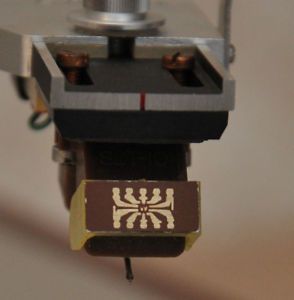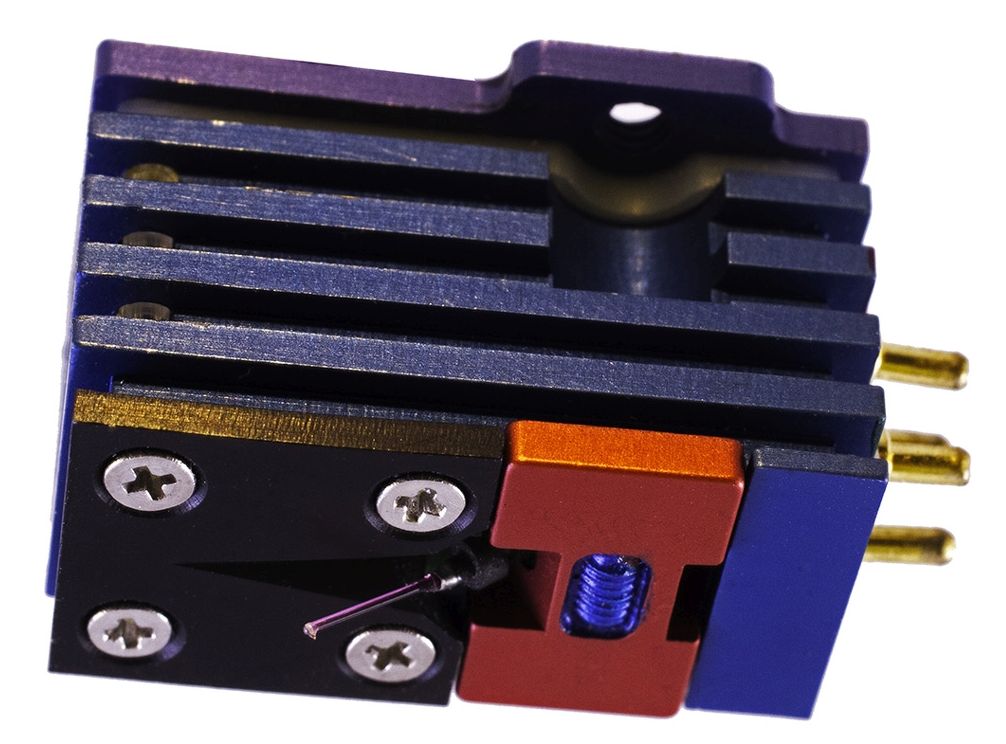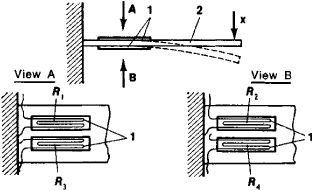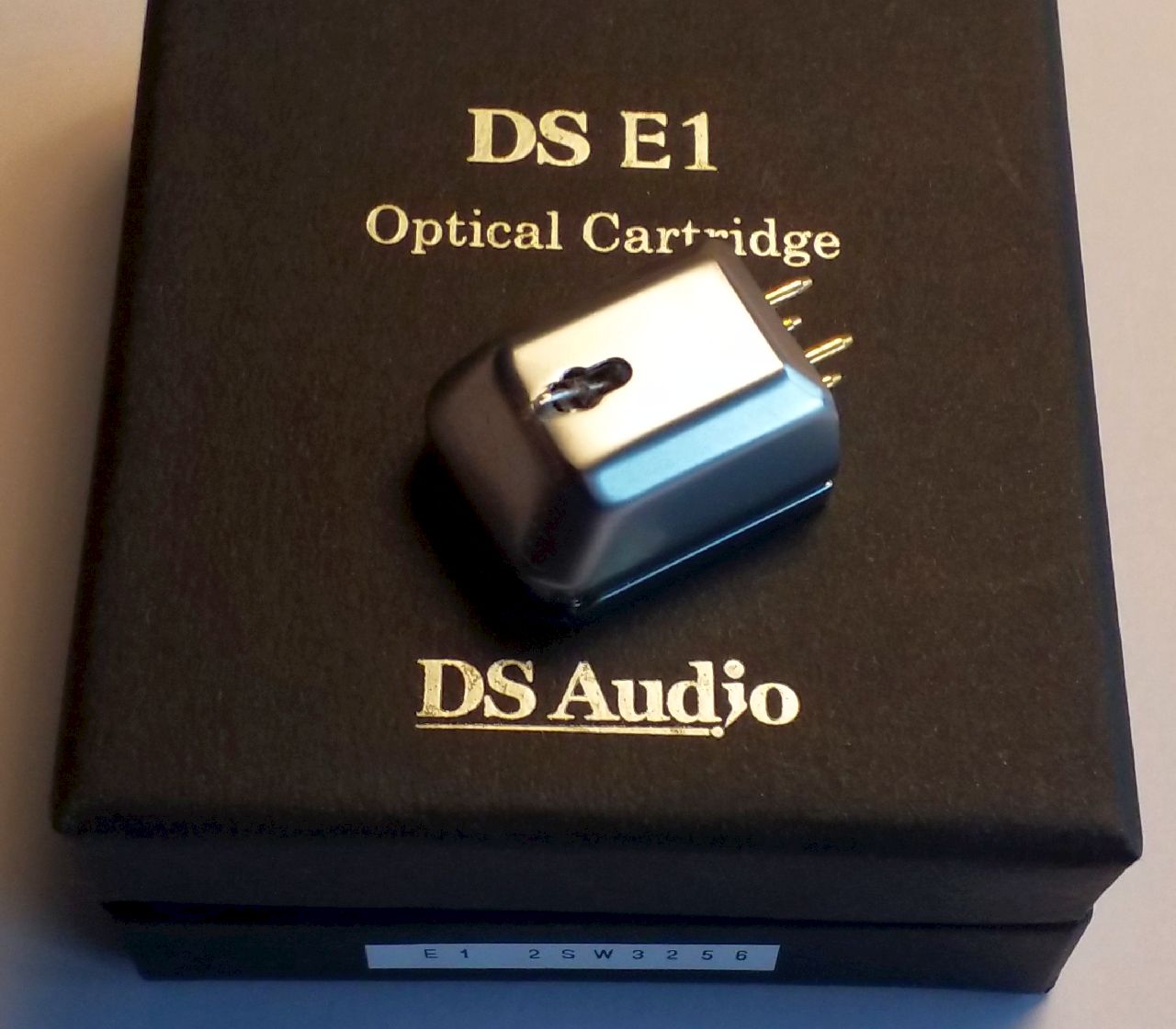![]() Pladespilleren.dk
Pladespilleren.dk
Pickuppen - specielle pickupper
Sidst opdateret 23. december 2023
Langt de fleste, kender kun til de almindelige MM, MC og MI pickupper. Reelt er der dog nogle flere og så også nogle ret specielle inden for de normale principper.
I gamle dage var der
krystalpickupper, som de der er gamle nok kender til. De havde en
lille knap i fronten, så man kunne skifte nål til 78'ere. Der kom senere nogle mere hifi-egnede af samme type.
Blandt de anderledes hifi typer i denne esoteriske klasse, kan nævnes:
Strain gauge
Piezo Elektrisk
Elektrostatisk
Krystal
Lys/LED
Mikrofon PU
STRAIN GAUGE
 Her
er der tale om et rent elektro mekanisk system, uden magneter og
spoler. Billedet til venster viser en Sao Win, som fik fantastisk
omtale tilbage i 80'erne. Der var også strain gauge pickupper fra XXX.
I dag har vi typer fra Soundsmith i USA-
Her
er der tale om et rent elektro mekanisk system, uden magneter og
spoler. Billedet til venster viser en Sao Win, som fik fantastisk
omtale tilbage i 80'erne. Der var også strain gauge pickupper fra XXX.
I dag har vi typer fra Soundsmith i USA-
I stedet for spoler og magneter har vi selve strain gage elementet, der også bruges til mange andre formål. F.eks. fintfølende vægte, måleudstyr og andet. Rent teknisk er der tale om et stykke metal med den egenskab, at den ændrer modstand ved mekanisk påvirkning. Pickuppen påtrykkes en let DC spænding, der moduleres af signalet fra pickuppen i rillen. Det skaber et forholdsvis højt udgangssignal fra DC og op til langt over det hørbare område.
Samtidig har Strain Gage den fordel, at det mekaniske output tilnærmelsesvis har en modsat RIAA kurve. Der er tale om en såkald "displacement transducer", der i kraft af princippet har en frekvensafvigelse, som tilnærmelsesvise svarer til en anti RIAA kurve. Der kræves kun forholdsvis nem korrektion i den tilkoblede elektronik. Udgangssignalet er på linie med CD og der skal altså ikke bruges nogen RIAA.
Her langt mere udførlig forklaring fra Sound Smiths hjemmeside:
 The
Strain Gauge cartridge is not at all like any other cartridge. All
other cartridges, whether moving magnet, moving coil, or moving iron,
are "generators" - that is, you put motion in, and you get energy
out.....a tiny voltage that you amplify and send to your speakers. The
key here in describing all other cartridges is in the word
MOVING. All other cartridges need to move a mass around - a
magnet, and iron core with wires (moving "coil") or moving iron. They
are all magnetic generating systems, which require a mass to be
constantly moved to generate a voltage.
The
Strain Gauge cartridge is not at all like any other cartridge. All
other cartridges, whether moving magnet, moving coil, or moving iron,
are "generators" - that is, you put motion in, and you get energy
out.....a tiny voltage that you amplify and send to your speakers. The
key here in describing all other cartridges is in the word
MOVING. All other cartridges need to move a mass around - a
magnet, and iron core with wires (moving "coil") or moving iron. They
are all magnetic generating systems, which require a mass to be
constantly moved to generate a voltage.
When you move any mass, it has stored energy, just like your car when you get it going. When you need to turn, or slow down, the mass tries to keep you from doing so. Imagine a stylus in the groove of a record that must make lots of changes in direction to follow the groove walls. Imagine how the mass of the generating parts must restrain the stylus as it tries to move.
Now, imagine driving a car where you and the car have NO MASS. If you can, then you can understand only one reason why the Strain Gauge is so exciting; it has almost no "stored energy" in the moving system - there IS no large amount of "mass" to move around - it does NOT have to move around a magnet, or wire coils, or iron. This means that the stylus stays in much better statistical contact with the groove walls of your records because there is no large mass trying to keep it from doing so. Imagine how different that sounds.
Inertia (the law by which mass tends to stay at rest or continue in the direction in which it was moving) makes all styli "jitter" or jump about in the groove of the record, and not stay in intimate contact with the groove wall. If a stylus can't follow the groove wall, you cant hear what's on the record. Its that simple.
So how does it work if it doesn't generate a voltage???
The SG cartridge has two Strain Gauge elements, pieces of silicon crystal that when compressed or expanded by tiny amounts, change resistance. The cantilever suspension, a necessary part of any cartridge, is coupled to these elements. The energy that is usually always "lost" into the suspension of all cartridges is used to couple the stylus movement and create the signal in our Strain Gauge cartridge. It is also a purely "resistive" system, with no coils of wire to alter the high frequency performance, or pick up hum, noise or radio stations! Our preamp supplies it a flow of electricity, which it varies, and that gets amplified.
 Why no RIAA required??
Why no RIAA required??
The Strain Gauge cartridge does not use or require an RIAA playback filter because it inherently plays the RIAA recording EQ curve used on the record correctly. This is because the RIAA recording curve used to make the original master recording with a magnetic cutter head COMPENSATES for the normal cutter head velocity response and thereby results in a groove that is basically equal “displacement” for a signal that is swept from 20 Hz. to 20 Khz. and is an amplitude flat (equal volume) input signal. How does that happen? Simply. Without RIAA, the "velocity" response of the magnetic cutter head would normally cut a large displacement groove for low frequencies, and less displacement as the frequency rises. Using RIAA, which LOWERS the amplitude (volume) as the frequency lowers and raises it as the frequency increases, it "COMPENSATES" for the natural displacement differences of a magnetic cutter head's response and RESULTS in a basically equal displacement groove, for a flat, frequency swept (20 to 20K) input signal. Since normal magnetic cartridges are velocity sensitive devices (whose output is sensitive or proportional to velocity), they need the RIAA inverse filter to result in a flat playback response of a groove cut with an RIAA recording curve. However, since the Strain Gauge is a DISPLACEMENT sensitive device, it automatically produces a basically flat response from a RIAA encoded groove, which as stated above, is a basically equal displacement recorded groove.
The Strain Gauge cartridge is a displacement device, producing an output that is dependent and directly proportional to the amount of displacement of the stylus, NOT the velocity, like magnetic cartridges. It therefore inherently plays the RIAA encoded groove correctly. If one inspects the RIAA EQ, one will discover that there are two areas that occur where a displacement type cartridge will deviate a small amount from a perfectly flat playback of the recorded RIAA groove, and therefore will not produce a perfectly flat response.
Attempts made in the distant past to perfectly and absolutely correct Strain Gauge cartridges for any amplitude anomaly have required complex equalization circuits, which add circuitry. Adding circuitry to the signal path is strongly against our audio faith tradition. It is the Soundsmith’s belief that human hearing is much more forgiving of amplitude errors than time errors, so we have made the required but absolutely minimal efforts to correct for any amplitude deviation from absolute flatness. The result is a very flat signal that does not deviate from the RIAA curve in an appreciable manner. We have also done it with NO ADDITIONAL circuitry that the signal must pass through. We believe that is the right way to do things.
Because it has ultra-low moving mass, and because it uses no wire coils, it has a high frequency performance to beyond 70 Khz. Because it goes all the way down to DC, we can use that DC information (on some models) to display tracking forces, forces on each groove wall, record eccentricity and "AC" component of the tracking force (record warp). Because it does NOT have to move around a large mass, and has almost not "stored" energy in a moving system that is required in magnetic cartridges, it can track details that MC and MM designs simply cannot hope to track as they suffer from the stylus "jittering" or chattering down the groove walls due to reflected energy from the generator. The stylus in a properly designed SG cartridge therefore stays in intimate contact with the record groove. And because we engineered it carefully, our Strain Gauge has user replaceable styli, a first for high end cartridges.
PIEZO ELETRISK eller KERAMISK PICKUP
ELEKTROSTATISK PICKUP
Her tænker jeg i første omgang på Stax, som nok er meste kendt for deres hovedtelefoner.
Krystal
LYS / OPTISK PICKUP
De første pickupper der aflæste signalet optisk kom fra Toshiba, Sharp og andre. Det var tilbage i 80'erne og de virkede med en elektrisk pære der leverede lys til en optisk film. Mekaniks var der stadig en nål i rillen, som variede lyset internt i pickuppen. Det blev ikke lige nogen stor succes. Teknologien var ikke rigtigt udviklet og pærer bliver varme. Det hele gik i stykker forholdsvis hurtigt.
Men så her omkring 2017 skete der noget. Det japanske firma DS-Audio så lyset - så at sige! De havde teknologien og udviklede en pickup, der faktisk virkede. Den fik ikke den helt store mvelkomst og mange troede det var en digital aftaster. Princippet blev dog udviklet og i dag (2020) er der 4 pickupper i programmet, samt 4 forskellige forstærkerbokse, som søreger for strøm og konvertering til et liniesignal ud. Se testen samt nærmere beskrivelse af DS-E1 her: DS-E1 LYS PICKUP
PI